In this article, I will guide you through the importance of food preservation, various preservation methods, and how you can integrate them into your food security pantry.
Get ready to embark on a journey of delicious flavors, sustainable practices, and long-term food storage solutions
Key Takeaways:
- Food preservation is essential for stocking your pantry with nutritious and long-lasting options.
- Various food preservation methods, such as canning, dehydrating, making preserves, fermenting, and freezing, offer different advantages.
- Preserved food can save you money, reduce food waste, and provide access to safe and nutritious options during challenging times.
- Learning food preservation skills helps combat food insecurity and ensures a well-stocked pantry for the long term.
- By integrating zero-waste kitchen tips, you can minimize food waste and make the most of your fresh produce.
Food preservation is an essential skill that allows you to stock your pantry with high-quality, nutritious, and long-lasting food.
Whether you’re looking to save money, reduce food waste, or prepare for uncertain times, mastering the art of long-term food preservation is a valuable investment.
From canning and dehydrating to making preserves, fermenting, and freezing, you have a range of options to choose from based on your preferences and needs. These methods not only extend the shelf life of food but also enhance its flavor and nutritional value.
Table of Contents
Why Is Food Preservation an Essential Skill?
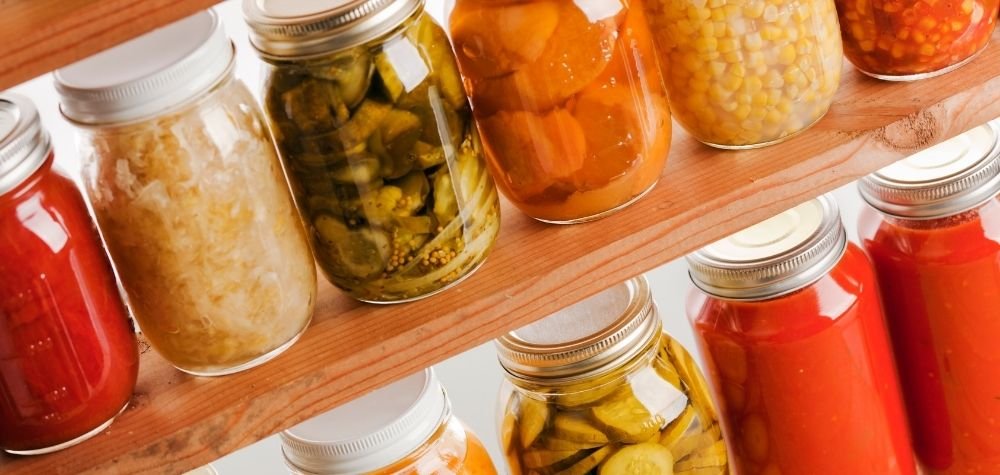
Food preservation is a crucial skill to have, especially when it comes to long-term storage and ensuring access to safe and nutritious food.
There are several reasons why mastering this skill is so essential.
Firstly, food preservation allows you to save money.
By preserving your own food, you can reduce your reliance on store-bought items and take advantage of sales and bulk purchases. This not only helps to lower your grocery bills but also ensures that you have a well-stocked pantry, even during times of scarcity.
Secondly, food preservation reduces food waste.
By preserving excess produce or ingredients, you can extend their shelf life and minimize spoilage.
This is not only environmentally friendly but also helps to combat food insecurity by ensuring that edible food doesn’t go to waste.
Lastly, food preservation provides you with access to safe and nutritious food during challenging times.
By storing preserved items, such as canned goods, dehydrated snacks, or frozen produce, you can create a reliable food source that can sustain you during emergencies or situations where fresh food is not readily available.
Best Methods for Long-Term Food Preservation
There are various methods of food preservation that offer different advantages in terms of taste, nutrition, and storage longevity.
Some of the best methods include:
- Canning: This method involves sealing food in airtight jars, making it ideal for preserving jams, jellies, soups, and more.
- Dehydrating: By removing moisture from food, dehydrating results in lightweight and nutrient-dense options, such as dried fruits and jerky.
- Making Preserves: This method involves cooking fruit or juice to create delicious jams, jellies, chutneys, and pickles.
- Fermenting: By harnessing natural bacteria, fermentation preserves food while adding unique flavors and probiotic benefits.
- Freezing: Freezing is a simple and convenient method for preserving a wide range of foods, including fruits, vegetables, and meats.
By mastering these food preservation methods, you can ensure that your pantry is well-stocked with nutritious and long-lasting options, providing you with peace of mind and food security.
| Method | Advantages |
|---|---|
| Canning | Preserves jams, jellies, soups, and more |
| Dehydrating | Creates lightweight and nutrient-dense options |
| Making Preserves | Adds flavor and sweetness to your pantry |
| Fermenting | Preserves food while adding unique flavors and probiotic benefits |
| Freezing | Simple and convenient method for preserving food |
QUIZ: What's Your Disaster Response IQ?
Think you're beyond novice level? Start the quiz to know for sure.
Fighting Against Food Insecurity
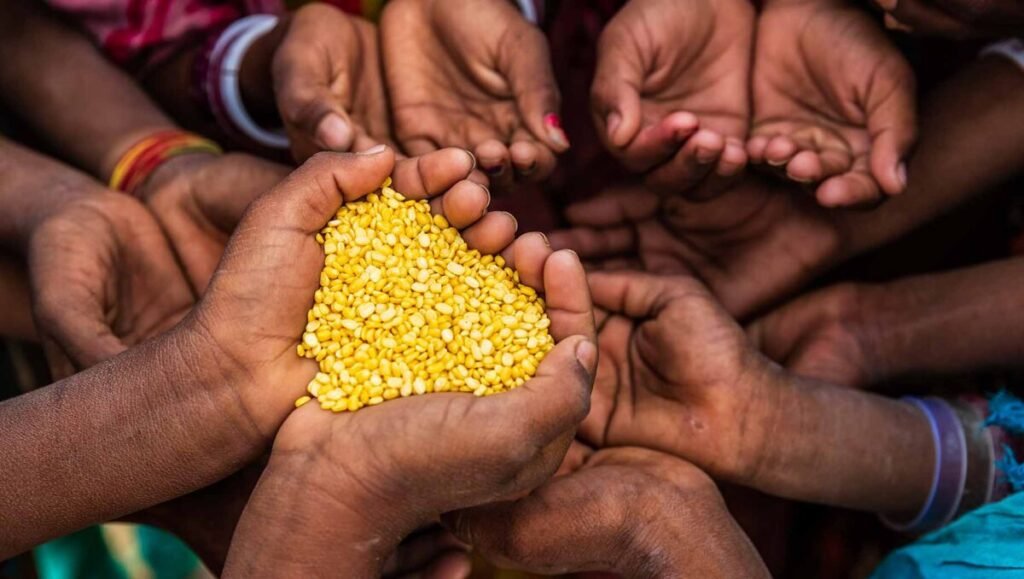
Preserving food for extended periods is a powerful tool in the fight against food insecurity.
Throughout history, people have relied on various preservation techniques to ensure access to food during challenging times.
From ancient civilizations to Native American tribes, individuals have used methods like drying, salting, and smoking to extend the shelf life of their food and provide sustenance when fresh produce is scarce.
Preserving fresh produce is especially important in combating food insecurity.
By preserving fruits and vegetables when they are in season and abundant, you can enjoy their benefits throughout the year.
Whether you choose to can, dehydrate, or make preserves, the process allows you to savor the flavors of summer even in the depths of winter.
Preservation Techniques of Ancient Times
- Drying: Drying food dehydrates it, removing moisture and inhibiting the growth of bacteria and mold. This method was often used for meats, grains, and fruits.
- Salting: Salting, or curing, involves packing food in salt to draw out moisture and create an inhospitable environment for pathogens. This technique was commonly used for fish and meat.
- Smoking: Smoking is a method of preserving food that combines heat, smoke, and airflow to slow down spoilage and add flavor. It was widely used for meats and fish.
Benefits of Food Preservation
Preserving food not only helps in times of scarcity but also offers several other benefits.
By preserving your own food, you have control over the ingredients, ensuring that you have access to safe and nutritious meals. Additionally, preserving food reduces waste and saves money, as you can take advantage of seasonal abundance and avoid spoilage.
Beyond practical considerations, food preservation allows for culinary exploration.
With a pantry stocked full of preserved fruits, vegetables, and other ingredients, you can experiment with new recipes, try different flavor combinations, and create unique dishes year-round.
Ensuring Food Security
In today’s uncertain times, having a reliable source of safe and nutritious food is crucial.
By mastering the art of food preservation, you can contribute to your own food security and the well-being of your loved ones.
Whether through canning, dehydrating, making preserves, or other methods, preserving food for extended periods ensures that you always have nourishing options available, even when fresh produce is not readily accessible.
Food Preservation Methods
When it comes to long-term food storage, there are several effective methods that can help you preserve your food for extended periods.
Each method offers its own set of advantages, allowing you to choose the one that best suits your needs and preferences.
Let’s explore the different food preservation methods: canning, dehydrating, making preserves, fermenting, and freezing.
Canning
Canning is a popular method that involves sealing food in airtight jars.
This process creates a barrier that prevents spoilage and extends the shelf life of various foods.
Canned fruits, vegetables, soups, and even meats can last for extended periods without compromising their quality or flavor.
It’s essential to follow proper canning techniques and use the appropriate equipment to ensure safe and effective preservation.
QUIZ: Which Historical Survivor Are You?
Do you have what it takes like they did? Find out.
Dehydrating
Dehydrating is a method of removing moisture from food, resulting in lightweight and nutrient-dense products.
Dehydrated foods are not only great for long-term storage but also make convenient and nutritious snacks.
From dried fruits to jerky, dehydrating offers a wide range of options. You can also create powders and fruit leathers by dehydrating various ingredients. The process retains the nutritional content of the food, making it a healthy choice for your pantry.
Making Preserves
Making preserves, such as jams, jellies, chutneys, and pickles, is a flavorful way to preserve fruits and vegetables.
By cooking fruit or juice until it softens and thickens, you can create delicious sauces and spreads that can be enjoyed on their own or as ingredients in various dishes.
Pickles, on the other hand, involve placing sliced vegetables in a solution of water, salt, sugar, or vinegar, resulting in tangy and crunchy additions to your meals.
Fermenting
Fermentation is a traditional preservation method that not only prolongs the shelf life of food but also enhances its taste and nutritional value.
Through the natural process of fermentation, beneficial bacteria break down sugars and produce acids, resulting in delicious and probiotic-rich foods.
From sauerkraut to kimchi, fermented foods offer unique flavors and health benefits.
Experimenting with fermenting fruits, vegetables, dairy products, and even beverages can open up a world of culinary possibilities.
Freezing
Freezing is a simple yet convenient method for preserving food.
While it may not be suitable for long-term storage beyond a few months, freezing is an excellent way to extend the shelf life of highly perishable foods like fruits, vegetables, and meats.
By placing freshly harvested or purchased produce in the freezer, you can maintain their quality and nutritional value.
Properly freezing food requires understanding the best practices and ensuring that the packaging is airtight to prevent freezer burn.
| Method | Advantages |
|---|---|
| Canning | – Extends shelf life – Preserves a variety of foods – Safe and effective |
| Dehydrating | – Lightweight and nutrient-dense – Retains nutritional content – Versatile usage |
| Making Preserves | – Adds flavor and sweetness – Wide range of options – Tangy and crunchy additions |
| Fermenting | – Enhances taste and nutrition – Probiotic-rich options – Culinary experimentation |
| Freezing | – Extends shelf life temporarily – Maintains quality and nutrition – Convenient preservation |
Canning
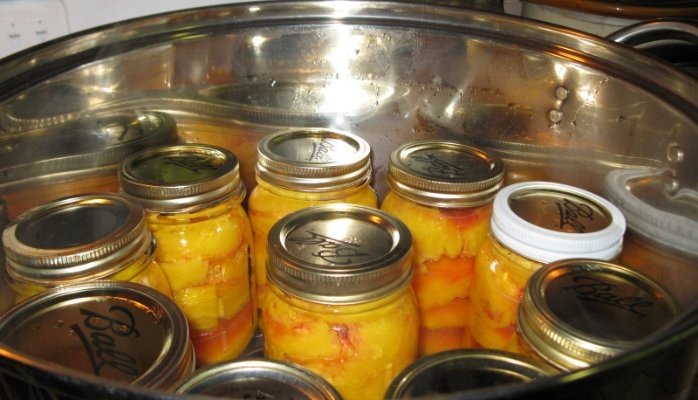
Canning is a popular method of food preservation that provides a reliable and safe way to stock your pantry with a variety of nutritious options.
It involves placing food in sealed jars to create an airtight environment, allowing the food to last for extended periods without the need for additional ingredients or seasonings.
Canned foods, such as jams, jellies, soups, and vegetables, can be stored for a long time, making them a valuable addition to any long-term food storage plan.
One of the advantages of canning is that it allows you to preserve a wide range of foods, including meat.
Advanced canners can successfully can meat, providing a valuable source of protein that can be stored for extended periods. Canned meat is a convenient option for emergency situations or when access to fresh meat is limited.
With proper canning techniques and guidelines, you can ensure that your canned meat remains safe for consumption.
When it comes to long-term food storage, canning is a versatile and effective method that offers convenience and peace of mind.
By incorporating canned food into your pantry, you can ensure that you have a variety of nutritious options available, even in challenging times.
Shelf Life of Canned Foods
| Food Item | Shelf Life |
|---|---|
| Jams and Jellies | 1-2 years |
| Soups | 2-5 years |
| Vegetables | 2-5 years |
| Meat | 2-5 years |
Dehydrating
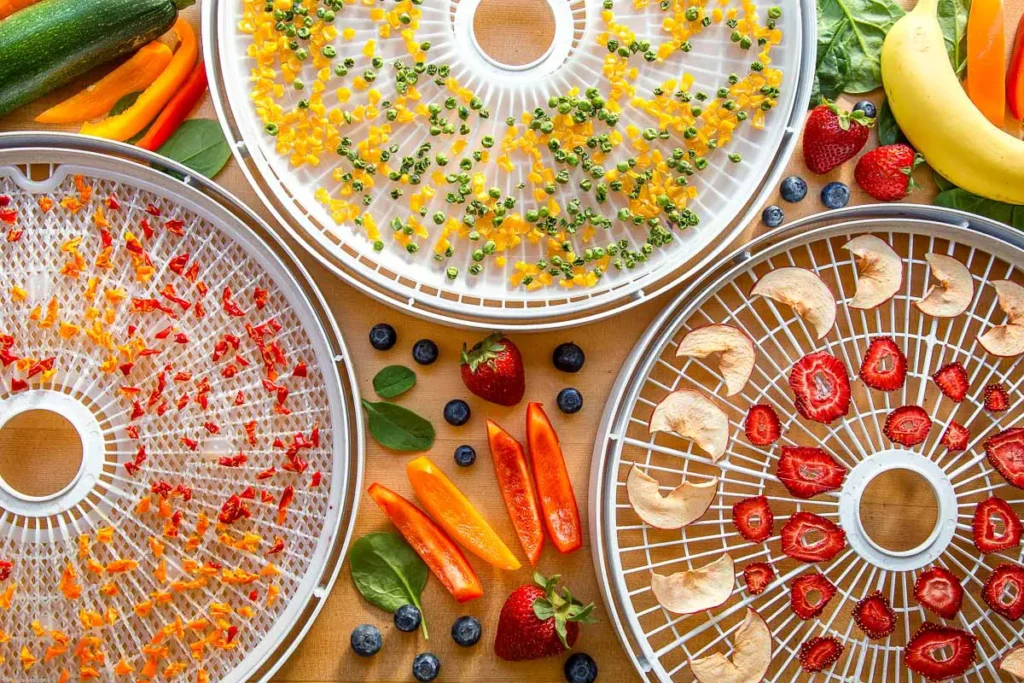
Dehydrating is a fantastic method of food preservation that offers a wide range of benefits.
By removing moisture from food, dehydrated products become lightweight, compact, and long-lasting.
Not only does this make them ideal for long-term storage, but it also helps retain their nutritional content. Dehydrated foods are packed with nutrients and can be used in various ways, making them a versatile addition to your pantry.
One of the great advantages of dehydrating is that it allows you to create nutritious snacks.
Instead of relying on processed options, you can make your own dehydrated fruits, vegetables, and even herbs.
These snacks are not only delicious but also a healthier alternative, as no salt or sugar is added during the process. Plus, dehydrated foods are easy to carry on-the-go, making them perfect for hiking or camping trips.
If you’re looking to add unique flavors to your meals, dehydrating garlic is a fantastic option.
Dehydrated garlic can be ground into a powder or used as minced flakes to enhance the taste of savory dishes.
It adds a concentrated garlic flavor that is both intense and aromatic. By dehydrating garlic, you can have this culinary staple readily available in your kitchen, ensuring that you never run out and can always add a burst of flavor to your favorite recipes.
How to Dehydrate Food
- Choose fresh, ripe produce or herbs.
- Wash and prepare the fruits, vegetables, or herbs as needed.
- Slice or chop them into uniformly sized pieces.
- Arrange the pieces on a dehydrator tray or baking sheet.
- Set the dehydrator or oven to the appropriate temperature.
- Dehydrate the food until it reaches the desired level of dryness.
- Store the dehydrated food in airtight containers in a cool, dry place.
By following these simple steps, you can harness the power of dehydration to create flavorful and nutritious additions to your meals.
Making Preserves
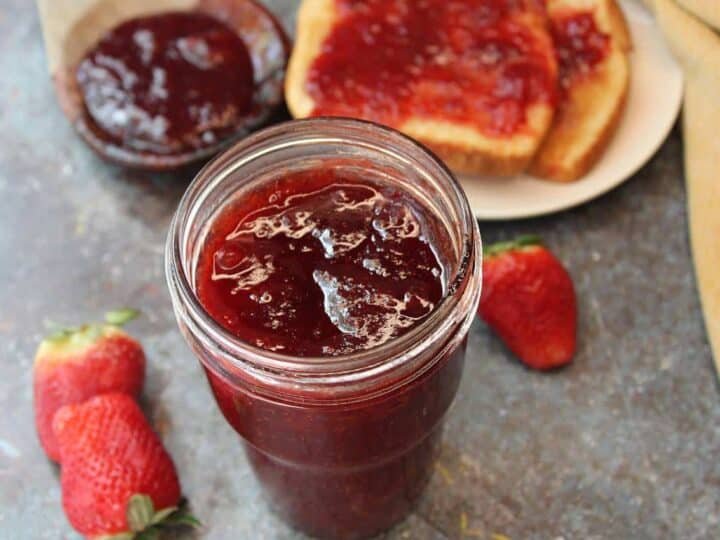
When it comes to food preservation, making preserves is a delightful and flavorful technique to add a burst of taste to your pantry.
Whether you’re a fan of jams, jellies, chutneys, or pickles, there are endless possibilities to explore.
By cooking fruits or juices until they soften and thicken into a sauce, you can create tantalizing spreads like jams and jellies. These preserves can be enjoyed on toast, biscuits, or used as an ingredient in various dishes.
Chutneys, on the other hand, are a wonderful accompaniment to savory dishes.
Made with a combination of fruits, vegetables, herbs, and spices, chutneys offer a unique blend of sweet, tangy, and spicy flavors.
They can be paired with meats, cheeses, or used as a dipping sauce for samosas or pakoras.
For those who crave a tangy and crunchy addition to their meals, pickles are the perfect choice.
Made by placing sliced vegetables in a solution of water, salt, sugar, or vinegar, pickles offer a refreshing and zesty flavor to any dish. From classic cucumber pickles to pickled carrots, beets, or radishes, the options are endless.
Benefits of Making Preserves:
- Preserves add flavor and sweetness to your pantry
- They can be used as spreads, ingredients, or accompaniments
- Preserves allow you to enjoy the taste of seasonal fruits and vegetables throughout the year
- Jams, jellies, and chutneys can be a thoughtful homemade gift
- Pickles provide a tangy and crunchy element to enhance your meals
Making your own preserves is not only a great way to preserve the flavors of fresh produce but also a creative and satisfying endeavor.
Explore different recipes, experiment with unique flavor combinations, and enjoy the delicious results of your homemade preserves.
Fermenting
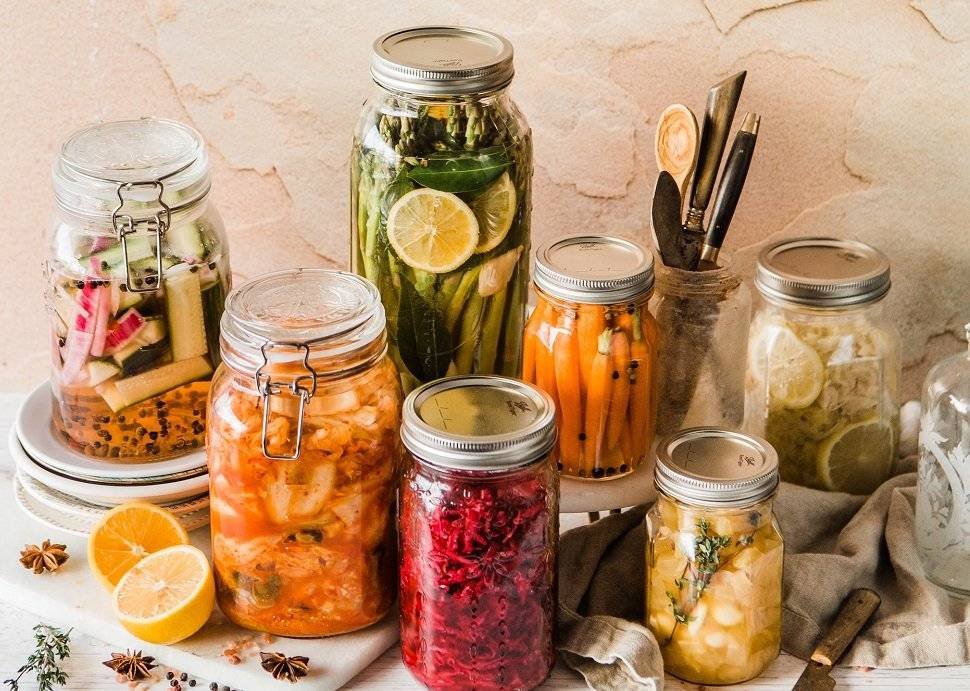
Fermentation is a fascinating method of preserving food that has been used for centuries.
It involves harnessing the power of natural bacteria to transform fruits, vegetables, dairy products, and even beverages into probiotic-rich delights.
Fermented foods like sauerkraut, kimchi, yogurt, and kombucha not only offer unique flavors but also provide numerous health benefits.
When fruits and vegetables ferment, their sugars are converted into organic acids and gases, creating a tangy and slightly effervescent taste.
This natural process not only enhances the flavor of the food but also promotes the growth of beneficial bacteria, which can improve digestion, boost the immune system, and support overall gut health.
Fermenting Fruits and Vegetables
You can ferment a wide range of fruits and vegetables, allowing you to enjoy their flavors and reap the benefits of probiotics year-round.
Here are a few examples:
- Try fermenting cabbage and other cruciferous vegetables to create sauerkraut or kimchi. These fermented delights are packed with vitamins, minerals, and antioxidants.
- Experiment with fermenting fruits like apples, pears, and berries to create tangy fruit chutneys or compotes. These make wonderful toppings for yogurt or toast.
- Don’t forget about pickles! You can ferment cucumbers, carrots, radishes, and other vegetables to create crunchy and delicious homemade pickles. The natural fermentation process adds depth of flavor and a pleasant tang.
By learning the art of fermenting, you can elevate your culinary skills and enjoy the unique flavors and health benefits of probiotic-rich foods.
Start small with a few basic recipes, and soon you’ll be exploring your own creations and sharing them with others.
Freezing: A Convenient Method for Long-Term Food Storage
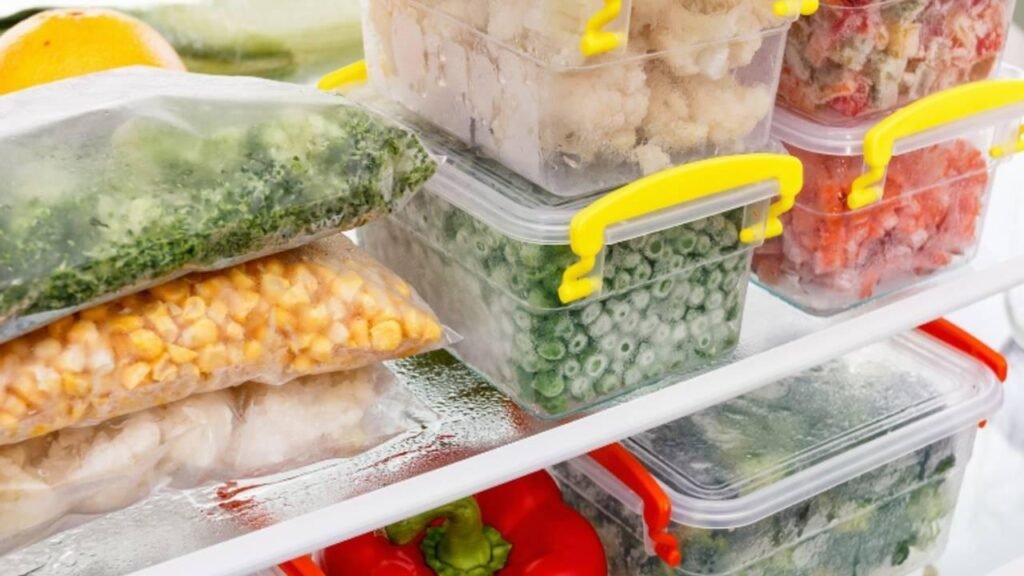
Freezing is a popular and convenient method for preserving food, allowing you to extend the shelf life of perishable items and maintain their quality for an extended period.
Whether you have an abundance of fresh produce from your garden or want to stock up on meats and other perishables, freezing provides an excellent solution for long-term food storage.
By freezing fresh produce, you can preserve its nutritional value and enjoy the flavors of summer throughout the year.
Whether it’s berries for smoothies, vegetables for stir-fries, or herbs for seasoning, freezing locks in the freshness, making it a breeze to incorporate these ingredients into your meals.
Additionally, freezing allows you to reduce food waste by preventing spoilage and extending the usability of various food items.
When freezing food, it’s crucial to follow proper techniques to ensure optimal results.
Start by cleaning and preparing the produce, removing any damaged areas or unwanted parts. Blanching certain vegetables, such as broccoli or green beans, for a brief period before freezing can help preserve their color, texture, and nutritional value.
Once prepared, packaging the food in airtight containers or freezer bags will help prevent freezer burn and maintain the quality of the food during storage.
Freezing Tips and Guidelines:
- Label and date your frozen items to keep track of their freshness and ensure proper rotation.
- Consider using vacuum-sealing equipment to remove excess air and further extend the shelf life of frozen food.
- Be mindful of the recommended storage times for different types of food. While freezing can preserve most foods for several months, some items, like seafood and ground meat, have shorter storage periods.
- Take advantage of freezer-safe containers or reusable silicone bags for a greener and more sustainable approach to freezing.
With proper freezing techniques and a well-organized freezer, you can enjoy the convenience, cost-savings, and long-term storage benefits that freezing provides.
Whether you’re planning ahead for busy weeks or looking to preserve the flavors of seasonal produce, freezing is a valuable tool in your food preservation arsenal.
| Food Item | Recommended Storage Time |
|---|---|
| Fruits | 8-12 months |
| Vegetables | 8-12 months |
| Meat (uncooked) | 2-12 months (varies by type) |
| Poultry (uncooked) | 9 months |
| Fish (uncooked) | 2-6 months (varies by type) |
| Baked Goods | 2-3 months |
Conclusion
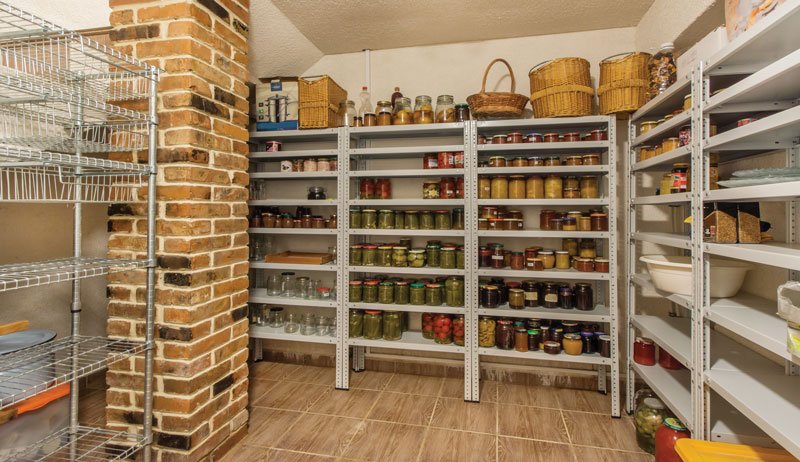
In conclusion, mastering the art of long-term food storage through various preservation techniques is crucial for creating a sustainable and well-stocked pantry.
Not only does it help you save money and reduce food waste, but it also ensures that you have access to safe and nutritious food even during challenging times.
Implementing zero-waste kitchen tips and tricks further minimizes waste and allows you to make the most of your fresh produce.
By utilizing every part of the food and exploring creative ways to use leftovers, you can maximize your resources and contribute to a more sustainable lifestyle.
Remember to take advantage of online guides, books, and tools/equipment specifically designed for food preservation.
These resources can enhance your skills and provide valuable insights into the best preservation methods for different types of food.
Whether you choose canning, dehydrating, making preserves, fermenting, or freezing, each technique offers its own benefits and allows you to enjoy the flavors and nutritional value of food for extended periods.
So get started on your food preservation journey today and build a pantry filled with long-lasting freshness!
FAQ
What is the importance of food preservation?
Food preservation allows you to stock your pantry with high-quality, nutritious, and long-lasting food. It helps you save money, reduce food waste, and have access to safe and nutritious food during challenging times.
What are the different food preservation methods?
There are several food preservation methods, including canning, dehydrating, making preserves, fermenting, and freezing. Each method offers different advantages in terms of taste, nutrition, and storage longevity.
How can food preservation help combat food insecurity?
By preserving food, you can extend its shelf life and reduce the need for frequent grocery shopping. Food preservation techniques ensure you have a well-stocked pantry with safe and nutritious food, even when fresh produce is scarce.
How long can canned foods last?
Canned foods, such as jams, jellies, soups, and vegetables, can last for extended periods without the need for additional ingredients or seasonings.
What can be dehydrated besides fruits and vegetables?
Dehydration can be used for various types of food, including garlic. Dehydrated foods are lightweight, nutrient-dense, and can be used in various ways, such as making powders or fruit leather.
How do you make preserves?
To make preserves, you cook fruit or juice until it softens and thickens into a sauce. This method can be used to create jams, jellies, chutneys, and other flavorful additions to your pantry.
What are the health benefits of fermented foods?
Fermented foods, such as sauerkraut and kimchi, are rich in probiotics that promote a healthy gut and immune system. Fermentation is a traditional method of food preservation that adds beneficial bacteria to your diet.
What foods are suitable for freezing?
Freezing is suitable for preserving highly perishable foods like fruits, vegetables, and meats. It extends their shelf life by drastically reducing spoiling time.
How can I minimize food waste in the kitchen?
Implement zero-waste kitchen tips and tricks to minimize food waste. Make the most of your fresh produce and learn different food preservation techniques to ensure nothing goes to waste.
Where can I find resources for learning food preservation?
You can find online guides, books, and tools/equipment for food preservation to enhance your skills. These resources will help you learn the different methods and fill your pantry with long-lasting freshness.



